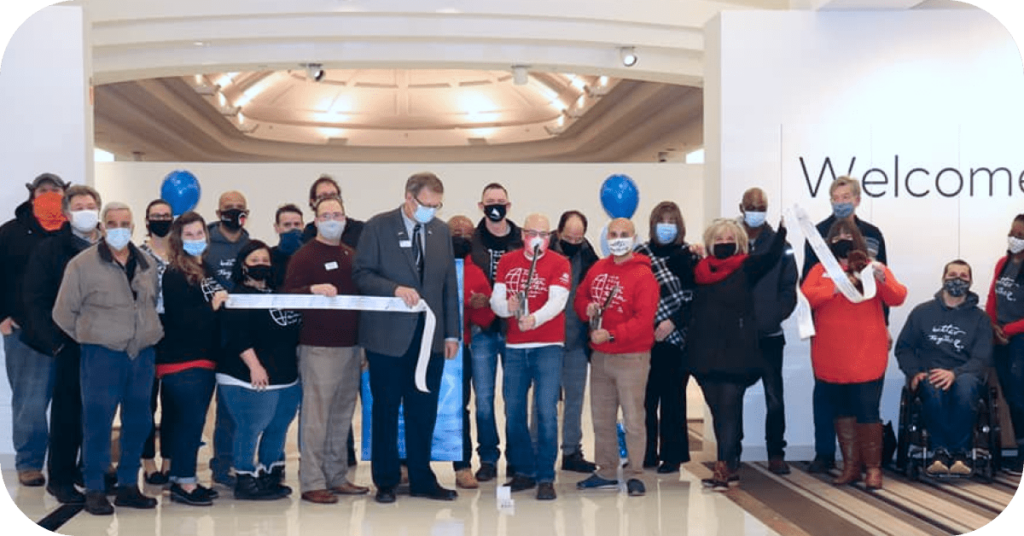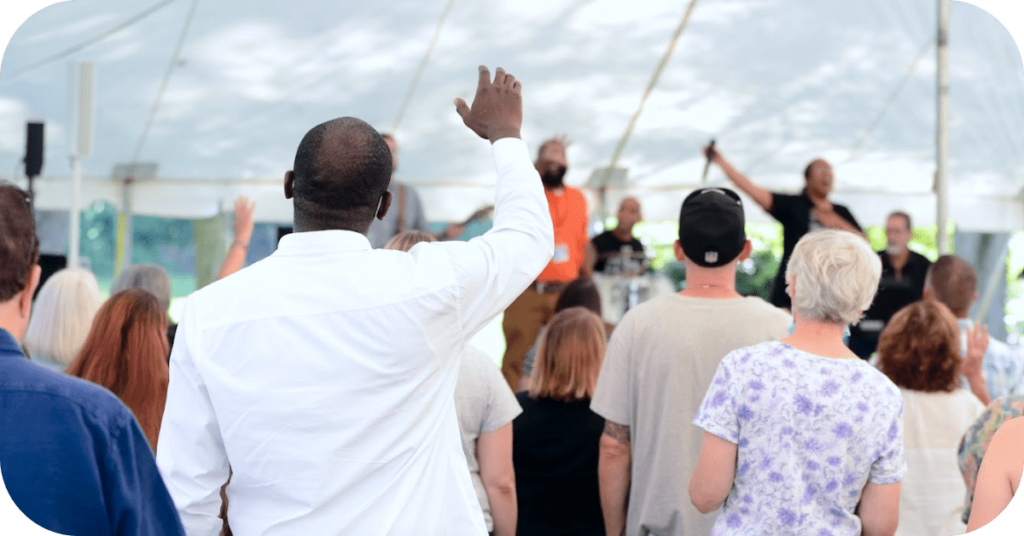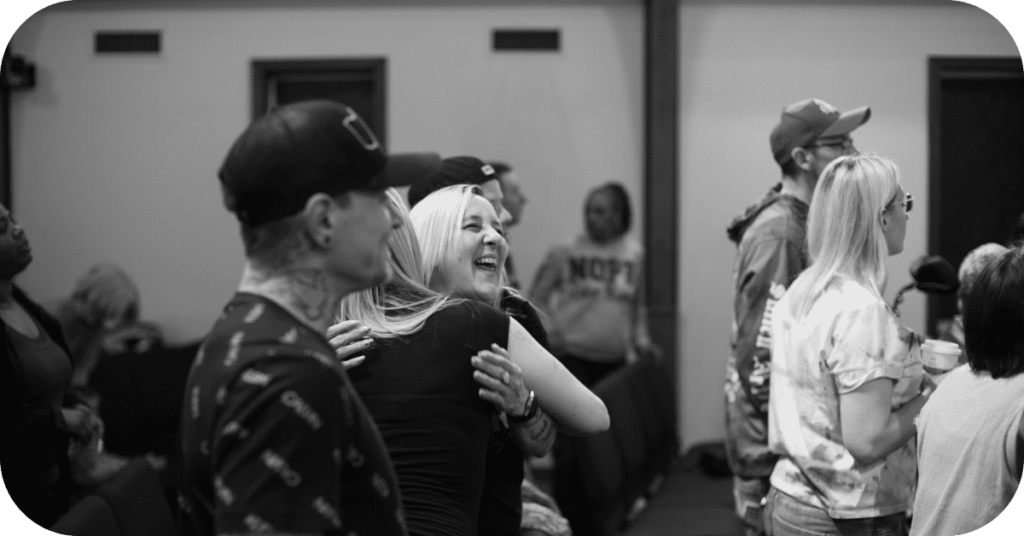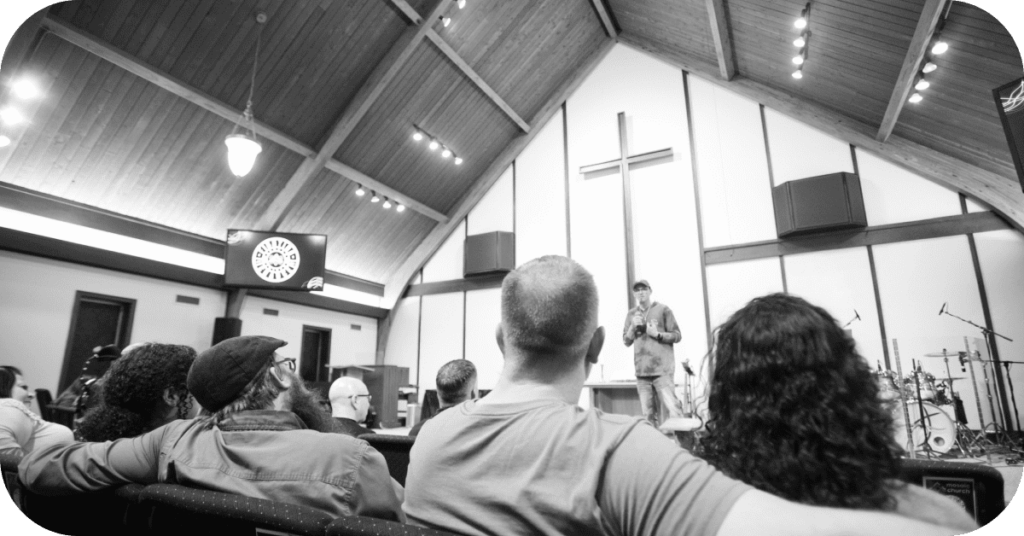Think about your past and present church experiences – services attended in your hometown and during travel, the congregations you’ve served and been served by. When you picture the sea of faces in each congregation, there’s a good chance that they are, group by group, pretty homogenous.
This sobering reality serves as a catalyst for Dr. Roz and his team at Mosaic Church, who have made it their mission to break this pattern and create a vibrant, multiethnic community.
“One of the most segregated times in America,” Dr. Rosario Picardo reminds us, “is still Sunday morning at 10am.”

Photo Credit: A moment captured during Mosaic Church’s Grand Opening of their permanent church home after years of navigating temporary locations.
Mosaic Church’s Multi-Faceted Approach to Congregational Unity and Diversity
A first-generation Sicilian American and co-pastor at Mosaic Church in Dayton, Ohio, Dr. Roz is also an author, a coach, and the holder of a Master of Divinity from Asbury Theological Seminary and a Doctor of Ministry from United Theological Seminary. When Dr. Roz began the work of growing Mosaic Church, the team had a particular objective at the forefront.
“From the very beginning, the focus was to become multi-ethnic. I believe it’s a biblical mandate. You know, Revelation 7:9: ‘Every tongue, tribe and nation will be worshiping together under heaven.’ And we don’t have to wait until we get to heaven to do that. We can do it now.”
After navigating through various temporary locations for several years, Mosaic Church has recently found its permanent home.
This milestone is a testament to their unwavering commitment to their vision.
What began as a hope and dream for a multiethnic congregation has become a reality. At Mosaic, the diverse tapestry of individuals from different walks of life is evident. People of various backgrounds, generations, and income levels gather under the banner of Jesus, fostering a dynamic mosaic of followers.
Their mission extends beyond the physical space; they strive to embody the unity Jesus prayed for in John 17.
And, while Jesus never guaranteed such unity, Mosaic Church embraces the profound impact it can have on the world by loving one another.

Photo Credit: Prayer and worship among the church community of Mosaic Church.
The Theological Underpinnings of Multi-Ethnicity and Fresh Expressions
When it comes to setting up a new church plant or Fresh Expression of church on a firm foundation, Dr. Roz points to two important threads.
1. Understand the importance of prayer and how it undergirds every aspect of church planting and Fresh Expressions.
Dr. Roz is clear on one fact: everything begins with prayer, the kind of prayer that unifies and connects a congregation. “It’s more than just a prayer chain where you’re calling so-and-so to pray,” he says. The kind of prayer he’s talking about is one that delves into the specifics – the who, what, when, where, and why. For Dr. Roz’s congregation, this has looked like prayer walks that are less focused on the laying of hands, and more focused on wide-open eyes on the lookout for what God is doing in the community and in the congregation’s midst.
“Just like any Fresh Expression or church planting, everything needs to be undergirded and bathed with prayer.”
As the church prays together to be led to the right people at the right time and that they’ll find the right space to begin, one specific area of focus is on finding the local community’s people of peace. Like Scripture’s Samaritan woman at the well, the Ethiopian eunuch, and the Phillipian jailer, these are the people ministries and church plants look to as ambassadors of the community. They’re often the de facto leaders who know everybody – they may not be regular churchgoers themselves, but they have, as Dr. Roz puts it, “a burden and a love toward you, and an affinity.”
The importance of seeking out these people of peace is that it shifts the process to one of invoking God’s presence in an area to acknowledging that God is already there, at work, and has been there for long before any particular ministry or church plant came on the scene.
2. Learn the art of asking the right questions and actively listening to truly understand the needs and assets of a community.
Have you ever experienced having a brilliant idea for a new initiative or Fresh Expressions at your church that didn’t strike a chord with your local community? Dr. Roz shares with us that as brilliant as these ideas are, their potential remains untapped unless they align with the community’s genuine needs and bridge existing gaps.
Genuine listening allows us to serve the community with authenticity and implement ideas that truly benefit them. Dr. Roz refers to this practice as “community exegesis,” which involves asking the neighbors in your community about the strengths, disadvantages, and opportunities within their context.
Which includes asking these three integrated questions:
- What do they believe are the community’s greatest assets or strengths?
- What are its disadvantages or a need that, if provided, the community would really benefit from?
- Where do the opportunities lie to make the greatest impact?
Truly listening to the answers you receive will set the process off on the right foot. Dr. Roz shares that he has found it helpful to casually go to the mayor’s office with those three questions in hand. With just those three powerful questions and an active listening ear, he and his teams have been able to learn about everything from the togetherness a community finds through a sports team, to the failed start of a brand-new library due to lack of books, to the pressing need for addiction recovery programs (resulting in Mosaic’s own ministry, Fighting Chance).
“Once we’re able to hear that we can go into peripheral discernment over those opportunities. And things can turn out way different than what you set out to do… We hear the cries of the people and the family members.”

Photo Credit: A moment captured during Mosaic Church’s Fighting Chance ministry that is about is about 99% lay-led at this point, according to Pastor Dr. Roz.
Empowering Lay Leaders by Way of a Transformative Church Culture
A key piece to creating a church culture as dynamic, diverse, and transformative as Mosaic’s, Dr. Roz says, lies in empowering lay leaders. Their addiction recovery ministry, Fighting Chance, is about 99% lay-led at this point, with Dr. Roz only there as a pastoral support and shepherd if needed or requested.
“For us, it’s crucial that we are led by laity, meaning that as much as the religious paid professional is great, we need to return the ministry back to the hands of lay folk.”
Curious about how to kick-start the journey of cultivating a transformative church culture? Dr. Roz shares invaluable insights on empowering lay leaders and fostering such a culture within the church:
- Identifying and empowering passionate individuals whose eyes are burning with fire for specific areas of ministry.
Nothing will get a ministry going faster and more successfully than a person on a mission. When someone in a congregation rises up with a vision, church or ministry leaders can only encourage them to do their research, begin praying, and begin the work in the community. As Dr. Roz puts it, when God gives someone a burning bush – you don’t squelch it; you pour some gasoline on it.
- Build teams with complementary strengths and giftings to compensate for each other’s weaknesses.
Dr. Roz emphasizes the importance of several vital roles within any team:
- the passionate individual mentioned above
- the detail-oriented administrative person, and
- the nurturing shepherd responsible for guiding both people and the movement.
“Understanding your own unique makeup and recognizing God’s design for you is key,” he explains. “Rather than focusing on areas where you lack expertise, it’s essential to surround yourself with a team of individuals who can compensate for those weaknesses.”
This principle applies not only to formal church leadership teams but also to small groups of lay leaders stepping up to tackle specific projects and ministries.
- Foster a culture of high expectations and low management, allowing space for creativity and diverse approaches.
For Dr. Roz, this looks like something as simple as breaking inherited church habits – for example, holding office hours and expecting people to come in off the street to see him – in favor of practices that get his congregation members out and into the streets and doing things. If you bring the right people on your team, he affirms, you won’t have to micromanage them. Things will happen!
- Embrace change and experimentation if culture redevelopment is necessary.
As Dr. Roz passionately puts it, “It’s easier to give birth than raise the dead.” While transforming a church culture may not occur in the blink of an eye, the irresistible call for church and ministry leaders to embark on an exhilarating journey toward change can sometimes be necessary to create vibrant and inviting spaces that breathe new life into churches on the verge of stagnation.
Recognizing that change can be challenging for anyone, Dr. Roz recommends preparing your congregation to embrace experimentation and cultivate a receptive heart for change. To kickstart this process, he suggests beginning with breakthrough prayer and equipping the congregation to extend their reach beyond themselves. Starting by acknowledging the current reality, both the positive and negative aspects, and evaluating the church’s impact on the community, serves as an excellent starting point.
Dr. Roz emphasizes the importance of establishing internal order before engaging with the community, including training church members to be welcoming and fostering an environment that genuinely embraces new visitors.
- Create a vision-driven culture that focuses on the vision catchers rather than the vision squelchers.
Many churches are full of people who are willing to do whatever is necessary to revitalize – who will tackle any change or new challenge with gusto. Unfortunately, there is also almost always a handful of people who are only happy complaining. Dr. Roz emphasizes the importance of shifting the attention from those vision squelchers onto the vision catchers. When church or ministry leadership devotes time in community exegesis with the people who are raring to go, rather than spending hours trying to appease the discontented minority, true change can happen, and a truly welcoming environment can be created for the larger community.

Photo Credit: Service at Mosaic Church
Empowering the Church for a Transformative Future
As we navigate the ever-changing landscape of the church, let us embrace a culture of empowerment and shared leadership found in a mixed ecology of Church.
By recognizing and affirming the giftings and passions of lay leaders, we can unlock the full potential of the church.
Together, we can build vibrant, multi-ethnic, and multi-generational communities where all are welcome, loved, and equipped to make a difference in the world.
To learn more about Dr. Roz and Mosaic, you can check out his recent book,
Dynamite Prayer: A 28 Day Experiment, or reach out to him at roz@wearemosaic.org.



